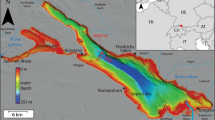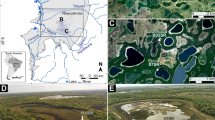Abstract
Lake Bonneville marl provides a stratigraphic record of lake history preserved in its carbonate minerals and stable isotopes. We have analyzed the marl in shallow cores taken at three localities in the Bonneville basin. Chronology for the cores is provided by dated volcanic ashes, ostracode biostratigraphy, and a distinctive lithologic unit believed to have been deposited during and immediately after the Bonneville Flood.
A core taken at Monument Point at the north shore of Great Salt Lake encompasses virtually the entire Bonneville lake cycle, including the 26.5 ka ‘Thiokol’ basaltic ash at the base and deposits representing the overflowing stage at the Provo shoreline at the top of the core. Two cores from the Old River Bed area near the threshold between the Sevier basin and the Great Salt Lake basin (the main body of Lake Bonneville) represent deposition from the end of the Stansbury oscillation (≈ 20 ka) to post-Provo time (≈ 13 ka), and one core from near Sunstone Knoll in the Sevier basin provides a nearly complete record of the period when Lake Bonneville flooded the Sevier basin (≈20–13 ka).
In all cores, percent calcium carbonate, the aragonite to calcite ratio, and percent sand were measured at approximately 2-cm intervals, and δ18O and δ13C were determined in one core from the Old River Bed area. The transgressive period from about 20 ka to 15 ka is represented in all cores, but the general trends and the details of the records are different, probably as a result of water chemistry and water balance differences between the main body and the Sevier basin because they were fed by different rivers and had different hypsometries. The Old River Bed marl sections are intermediate in position and composition between the Monument Point and Sunstone Knoll sections. Variations in marl composition at the Old River Bed, which are correlated with lake-level changes, were probably caused by changes in the relative proportions of water from the two basins, which were caused by shifts in water balance in the lake.
Similar content being viewed by others
References
Bathurst, R. G. C., 1975, Carbonate sediments and their diagenesis. Amsterdam, Elsevier, 658 pp.
Currey, D. R., 1982. Lake Bonneville: Selected features of relevance to neotectonic analysis. U.S. Geol. Survey Open-File Rept. 82–1070: 30 pp.
Currey, D. R., 1990. Quaternary paleolakes in the evolution of semidesert basins, with special emphasis on Lake Bonneville and the Great Basin, USA. Palaeogeogr., Palaeoclim., Palaeoecol. 76: 189–214.
Forester, R. M., 1987. Late Quaternary paleoclimate records from lacustrine ostracodes. In W. F. Ruddiman & H. E. Wright, Jr. (eds.), North America and adjacent oceans during the last deglaciation: Geol. Soc. Am., Geol. N. Am. K-3: 261–276.
Gat, J. R., 1980, The isotopes of hydrogen and oxygen in precipitation. In P. Fritz & J. C. Fontes (eds.), Handbook of environmental isotope geochemistry: V. IA: The terrestrial environment: Elsevier, Amsterdam, 21–47.
Gilbert, G. K., 1890. Lake Bonneville: U.S. Geol. Survey Mono. I: 438 pp.
Hahl, D. C. & J. C. Mundorff, 1968. An appraisal of the quality of surface water in the Sevier Lake basin, Utah, 1964. Utah Dept. Natural Res. Tech. Publ. 19, 41 pp.
Jarrett, R. D. & H. E. Malde, 1987. Paleodischarge of the late Pleistocene Bonneville Flood, Snake River, Idaho, computed from new evidence. Geol. Soc. Am. Bull. 99: 127–134.
Kelts, K., & M. Talbot, 1990. Lacustrine carbonates as geochemical archives of environmental change and biotic/abiotic interactions. In M. M. Tilzer & C. Serruya (eds.), Large lakes: Ecological structure and function. Berlin, Springer-Verlag: 288–315.
Machette, M. N., 1986. Calcium and magnesium carbonates. In M. J. Singer & P. Janitzky, (eds.), Field and laboratory procedures used in a soil chronosequence study. U.S. Geol. Survey Bull. 1648: 30–33.
Malde, H. E., 1968. The catastrophic late Pleistocene Bonneville Flood in the Snake River Plain, Idaho. U.S. Geol. Surv. Prof. Pap. 596, 52 pp.
McKenzie, J. A., 1985. Carbon isotopes and productivity in the lacustrine and marine environment. In W. Stumm, (ed.), Chemical processes in lakes: New York, John Wiley & Sons: 99–118.
Müller, G., G. Irion & U. Forstner, 1972. Formation and diagenesis of inorganic Ca-Mg carbonates in the lacustrine environment. Naturwissenschaften 59: 158–164.
O'Connor, J. E., 1993. Hydrology, hydraulics, and geomorphology of the Bonneville Flood. Geol. Soc. Am. Spec. Pap. 274, 83 pp.
Oviatt, C. G., 1987. Lake Bonneville stratigraphy at the Old River Bed. Utah. Am. J. Sci. 287: 383–398.
Oviatt, C. G., 1988. Late Pleistocene and Holocene lake fluctuations in the Sevier Lake basin, Utah. USA. J. Paleolim. 1: 9–21.
Oviatt, C. G., 1989. Quaternary geology of part of the Sevier Desert, Millard County, Utah. Utah Geol. Min. Survey Spec. Stud. 70, 41 pp.
Oviatt, C. G., 1991a. Stratigraphy of Lake Bonneville deposits along Grouse Creek, northwestern Utah. U.S. Geol. Survey Open-File Rept. 91–342, 22 pp.
Oviatt, C. G., 1991b. Lake Bonneville stratigraphic model: Geol. Soc. Am. Abs. Progs. 23: A99.
Oviatt, C. G., D. R. Currey & D. M. Miller, 1990. Age and paleoclimatic significance of the Stansbury shoreline of Lake Bonneville, northeastern Great Basin. Quat. Res. 33: 291–305.
Oviatt, C. G., D. R. Currey & D. Sack, 1992. Radiocarbon chronology of Lake Bonneville, eastern Great Basin, USA. Palaeogeogr., Palaeoclim., Palaeoecol. 99: 255–241.
Oviatt, C. G., W. D. McCoy & W. P. Nash, 1994. Sequence stratigraphy of lacustrine deposits: A Quaternary example from the Bonneville basin, Utah. Geol. Soc. Am. Bull. 106: 133–144.
Oviatt, C. G. & W. P. Nash, 1989. Late Pleistocene basaltic ash and volcanic eruptions in the Bonneville basin, Utah. Geol. Soc. Am. Bull. 101: 292–303.
Oviatt, C. G., D. Sack & T. J. Felger, 1994. Quaternary geologic map of the Old River Bed and vicinity, Millard, Juab, and Tooele Counties, Utah: Utah Geol. Survey Map 161.
Rozanski, K., L. Araguás-Araguás & R. Gonfiantini, 1993. Isotopic patterns in modern global precipitation. In P. K. Swart, K. C. Lohman, J. McKenzie & S. Savin (eds.), Climate change in continental isotopic records: Am. Geophys. U. Geophys. Mono. 78: 1–36.
Sack, D., 1992. Obliteration of surficial paleolake evidence in the Tule Valley subbasin of Lake Bonneville. In Quaternary coasts of the United States: Marine and lacustrine systems: SEPM (Soc. Sed. Geol.) Spec. Publ. 48: 427–433.
Spencer, R. J., M. J. Baedecker, H. P. Eugster, R. M. Forester, M. B. Goldhaber, B. F. Jones, K. Kelts, J. McKenzie, D. B. Madsen, S. L. Rettig, M. Rubin & C. J. Bowser, 1984. Great Salt Lake and precursors, Utah: The last 30 000 years. Contrib. Mineral. Petrol. 86: 321–334.
Spencer, R. J., H. P. Eugster, B. F. Jones & S. L. Rettig, 1985. Geochemistry of Great Salt Lake, Utah I: hydrochemistry since 1850. Geochim. Cosmochim. Acta 49: 727–737.
Talbot, M. R., 1990. A review of the palaeohydrological interpretation of carbon and oxygen isotopic ratios in primary lacustrine carbonates. Chemical Geology (Isotope Geoscience Section) 80: 261–279.
Talbot, M. R. & K. Kelts, 1990. Paleolimnological signatures from carbon and oxygen isotopic ratios in carbonates from organic carbon-rich lacustrine sediments. In B. J. Katz, (ed.), Lacustrine basin exploration: Case studies and modern analogs: Tulsa, Am. Assoc. Petrol. Geol. Mem. 50: 99–112.
Thiros, S. A., 1988. Selected data for Pahvant Valley and adjacent areas, Millard County, Utah, 1987. U.S. Geol. Surv. Open-File Rept. 88–195.
Thompson, R. S., L. J. Toolin, R. M. Forester & R. J. Spencer, 1990. Accelerator-mass spectrometer (AMS) radiocarbon dating of Pleistocene lake sediments in the Great Basin. Palaeogeogr., Palaeoclim., Palaeoecol. 78: 301–313.
Thompson, R. S., C. Whitlock, P. J. Bartlein, S. P. Harison, & W. G. Spaulding, 1993. Climate changes in the western United States since 18 000 yr B.P. In H. E. Wright, J. E. Kutzbach, T. Webb III, W. F. Ruddiman, F. A. Street-Perrott & P. J. Bartlein (eds.), Global climate since the last glacial maximum. Minneapolis, Univ. Minn. Press.: 468–513.
Author information
Authors and Affiliations
Additional information
This is the second paper in a series of papers published in this issue on ‘Climatic and Tectonic Rhythms in Lake Deposits’.
Rights and permissions
About this article
Cite this article
Oviatt, C.G., Habiger, G.D. & Hay, J.E. Variation in the composition of Lake Bonneville marl: a potential key to lake-level fluctuations and paleoclimate. J Paleolimnol 11, 19–30 (1994). https://doi.org/10.1007/BF00683268
Received:
Accepted:
Issue Date:
DOI: https://doi.org/10.1007/BF00683268




